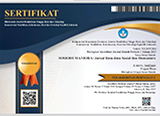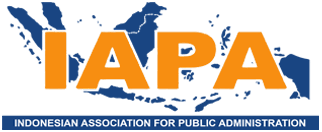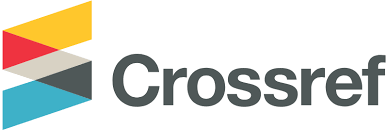GRICE’S COOPERATIVE PRINCIPLES VIOLATION IN THE COMMUNICATION OF CHILDREN WITH AUTISM
Abstract
The involvement of children with autism in social interaction is mostly at a lower level. It is due to the language obstacles faced by children with autism that become the reason why children with autism tend to violate the cooperative principles in communication. This study aims to demonstrate how children with autism violate Grice’s cooperative principles maxims and what causes it. The Grice’s cooperative principles maxims are the focus of this observation and 5 children with autism were the subjects of this study. The research was done in SLBN Surakarta which is the school for exceptional children in Surakarta. By utilizing the observational approach, the data were collected using recording and transcribing technique. Leech’s heuristic pragmatic analysis method was used to analyze the data. The results showed that 67.65% of utterances spoken by the children with autism violated 1 maxim, 20.59% utterances violated 2 maxims and 3 maxims violation was found in 2.94% utterances. 4 maxims violation was also found indicating that there are 8.82% utterances of the children with autism failed to fulfill cooperative principles. Language and social development problems are considered responsible for the violations well as their disability to stay focus are considered the cause of maxim of relevance become the most violated maxim in this study.
Keywords
Full Text:
PDFReferences
American Psychiatric Association. (2000). Diagnostic and Statistical Manual of Mental Disorders (DSM-IV) (4th ed.). Washington, DC: American Psychiatric Press.
Baron-Cohen, S & Bolton, P. (1993). Autism: The Facts. New York: Oxford University Press.
Baron-Cohen, S. (2008). The Facts: Autism and Asperger Syndorme (1st ed.). New York: Oxford University Press.
Dardjowidjojo, S. (2003). Psikolinguistik: Pengantar Pemahaman Bahasa Manusia. Jakarta: Yayasan Pustaka Obor Indonesia. [Indonesian]
Devi, L.N. & Qomaruddin, M. (2017). Prinsip Kerja Sama dalam Bahasa Transaksi Jual Beli Online di Tokopedia.com. Haluan Sastra Budaya, 1, (1), 86-96. Doi: https://doi.org/10.20961/hsb.v1i1.5204/ [Indonesian]
Dewi, D.M.C. (2014). Identifikasi Kemampuan Berbahasa Anak Autis di Sekolah Inklusif SD Negeri Giwangan, Yogyakarta. Universitas Negeri Yogyakarta : Unpublished Thesis [Indonesian]
Ezmar dan Ramli. 2014. Bahasa Anak Autis pada SLB Cinta Mandiri Lhoksumawe. Jurnal Metamorfosa, 2, (2), 1-18. [Indonesian]
Frith, U. (2008). Autism : Very Short Introduction. New York: Oxford University Press
Grice, H.P. (1989). Studies in the Way of Words. Cambridge, M A: Harvard University Press.
Grossman, R.B., Bemis, R.H., Skwerer, D.P. & Flushberg, H.T. (2010). Lexical and Affective Prosody in Children with High-Functioning Autism. Journal of Speech, Language, and Hearing Research, 53, 778-793. Doi: 10.1044/1092-4388(2009/08-0127)
Hill, E.L. & Frith, U. (2003). Understanding autism: Insights from mind and brain. Philosophical Transactions of the Royal Society B: Biological Sciences, 358, (1430), 281–289. https://doi.org/10.1098/rstb.2002.1209
Huang, Y. (2007). Pragmatics. New York: Oxford University Press.
Jones, C.D. & Schwartz, I.S. (2009). When Asking Questions is Not Enough: An Observational Studyof Social Communication Differences in High Functioning Children with Autism. Journal of Autism and Developmental Disorders, 39, 432-443. Doi: https://10.1007/s10803-008-0642-y/
Lam, G.L. & Yeung, S.S.S. (2012). Towards a convergent account of pragmatic language deficits in children with high-functioning autism: Depicting the phenotype using the Pragmatic Rating Scale. Research in Autism Spectrum Disorders, 6, 792-797. Doi: https://10.1016/j.rasd.2011.08.004/
Larkin, F., Hobson, J.A., Hobson, R.P., & Tolmie, A. (2017). Collaborative competence in dialogue: Pragmatic language impairment as a window onto the psychopathology of autism. Research in Autism Spectrum Disorders, 43–44 (September), 27–39. https://doi.org/10.1016/j.rasd.2017.09.004
Lazulfa, F.I. & Pamolango, V.A. (2017). A Study of Cooperative Principles in Conversation of Tenants at Kampoeng Inggris Pare, Kediri. Parafrase, 17, (1), 81-87. doi: https://doi.org/10.30996/parafrase.v17i1.1363/ [Indonesian]
Leech, G. (1993). Prinsip-prinsip Pragmatik. Jakarta: Universitas Indonesia Press
Loveland, K.A., Landry, S.H., Hughes, S.O., Hall, S.K. & McEvoy, R.E. (1988). Speech Acts and the Pragmatic Deficits of Autism. Journal of Speech and Hearing Research, 31, (4), 593-604. doi: 10.1044/jshr.3104.593/
Marshal, J., Sheller, B., Williams, B.J., Mancl, L. & Cowan, C. (2007) Cooperation Predictors for Dental Patients with Autism. Pediatric Dentstry, 9, (5), 369-376. Retrieved from: https://www.ncbi.nlm.nih.gov/pubmed/18027770/
Mattard-Labrecque, C., Amor, L.B. & Couture, M.M. (2013) Children with Autism and Attention Difficulties: A Pilot Study of the Association between Sensory, Motor, and Adaptive Behaviors. Journal of the Canadian Academy of Child and Adolescent Psychiatry, 22, (2), 139-146. Retrieved from: https://www.ncbi.nlm.nih.gov/pmc/articles/PMC3647630/
Noterdaeme, M., Wriedt, E., & Hӧhne, C. (2010). Asperger’s Syndrome and High-Functioning Autism: Language, Motor and Cognitive Profiles. European Child and Adolescent Psychiatry, 19, 475-481. doi: https://10.1007/s00787-009-0057-0/
Paul, R.., Bianchi, N., Augustyn, A., Klin, A. & Volkmar, F.R. (2008). Production of Syllable Stress in Speakers with Autism Spectrum Disorders. Research in Autism Spectrum Disorders, 2008, (2), 110-124. doi: 10.1016/j.rasd.2007.04.001
Peeters, T. (2012). Panduan Autisme Terlengkap. Jakarta: Dian Rakyat Press. [Indonesian]
Raharja, A.U.S & Rosyidha, A. (2019). Maxim of Cooperative Principle Violation by Dodit Mulyanto in Stand-up Comedy Indonesia Season 4. Journal of Pragmatic Research, 1, (1), 43-61. doi: http://dx.doi.org/10.1836/jopr.v1i1.62-77/ [Indonesian]
Robiah, S., Ibrahim, A.S. & Rofi’udin, A. (2016). Respon Tutur Siswa Autis terhadap Tutur Direktif Guru dalam Interaksi Pembelajaran di Kelas. Bahasa dan Seni, 44, (2), 111-124. doi: http://dx.doi.org/10.17977/um015v44i22016p111/ [Indonesian]
Rubin, E. & Lennon, L. (2004). Challenges in Social Communication in Asperger Syndrome and Hig-Functioning Autism. Topic in Language Disorders, 24, (4), 271-285. doi: 10.1097/00011363-200410000-00005
Sari, H.C. (2013). Pengaruh Dongeng terhadap Kemampuan Bicara Anak Autis Disertai Gangguan Bahasa di SDLB Shanti Kosala, Nganjuk. Jurnal Pendidikan Khusus, 1 (1). [Indonesian]
Sastry, A. & Aguirre, B. (2014). Parenting Anak dengan Autisme: Solusi, Strategi, dan Saran Praktis untuk Membantu Keluarga Anda. Yogyakarta: Pustaka Pelajar. [Indonesian]
Shinta, Q. (2010). Pemerolehan Pragmatik dalam Bahasa Anak Studi Kasus Prinsip Kerja Sama – Maksim Grice pada Anak Usia Enam (6) Tahun. Dinamika Bahasa Dan Budaya, 4(2), 66-83. Retrieved from https://www.unisbank.ac.id/ojs/index.php/fbib1/article/view/423/ [Indonesian]
Shriberg, L.D., Paul, R., McSweeny, J.L., Klin, A., Volkmar, F. R. & Cohen, D.J. (2001). Speech and Prosody Characteristics of Adolescents and Adults with High Functioning Autism and Asperger Syndrome. Journal of Speech, Language, and Hearing Research, 44, 1097–1115. doi: https://1092-4388/01/4405-1097/
Shriberg, L.D., Paul, R., Black, L.M., & van Santen, J.P. (2011). The Hypothesis of Apraxia of Speech in Children with Autism Spectrum Disorder. Journal of Autism and Developmental Disorders, 41, 405-426. doi: https://10.1007/s10803-010-1117-5/
Stein, L.I., Lane, C.J., Williams, M.E., Dawson, M.E., Polido, J.C. & Cermak, S.A. (2014). Physiological and Behavioral Stress and Anxiety in Children with Autism Spectrum Disorders during Routine Oral Care. BioMed Research International, 2014, 1-10. Doi: http://dx.doi.org/10.1155/2014/694876/
Sudaryanto. (1993). Metoda dan Aneka Teknik Analisis Bahasa. Yogyakarta: Duta Wacana University Press. [Indonesian]
Sussman, S. & Sklar, J.L. (1969). The Social Awareness of Autistic Children. American Journal of Orthopsychiatry, 39 (5), 798-806. doi: https://doi.org/10.1111/j.1939-0025.1969.tb00662.x
Whyte, E.M. & Nelson, K.E. (2015). Trajectories of Pragmatic and Nonliteral Language Development in Children with Autism Spectrum Disorders. Journal of Communication Disorders, 54. 2-14.doi: http://dx.doi.org/10.1016/j.jcomdis.2015.01.001/
Zebua, E., Rukmini, D. & Saleh, M. (2017). The Violation and Flouting of Cooperative Principles in the Ellen Degeneres Talk Show. Language Circle: Journal of Language and Literature, 12, (1), 103-113. doi: https://doi.org/10.15294/lc.v12i1.11474
DOI: https://doi.org/10.24198/sosiohumaniora.v22i1.24378
Refbacks
- There are currently no refbacks.
Copyright (c) 2020 Sosiohumaniora

This work is licensed under a Creative Commons Attribution-ShareAlike 4.0 International License.
Sosiohumaniora Indexed By:
 Creation is distributed below Creative Commons Attribution-ShareAlike 4.0 International License.
Creation is distributed below Creative Commons Attribution-ShareAlike 4.0 International License.
Published By:
Faculty of Social and Political Sciences, Universitas Padjadjaran
Dean's Building 2nd Floor, Jalan Ir. Soekarno Km. 21 Jatinangor, Sumedang 45363
Email: jurnal.sosiohumaniorafisip@gmail.com
















